Exploring Dubai's Iconic Musical Fountain Experience
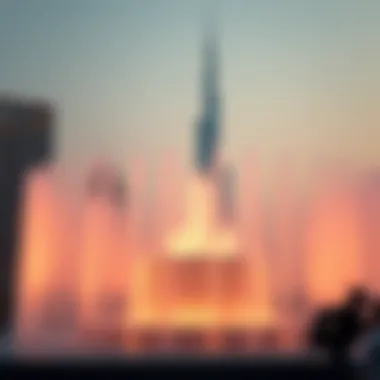
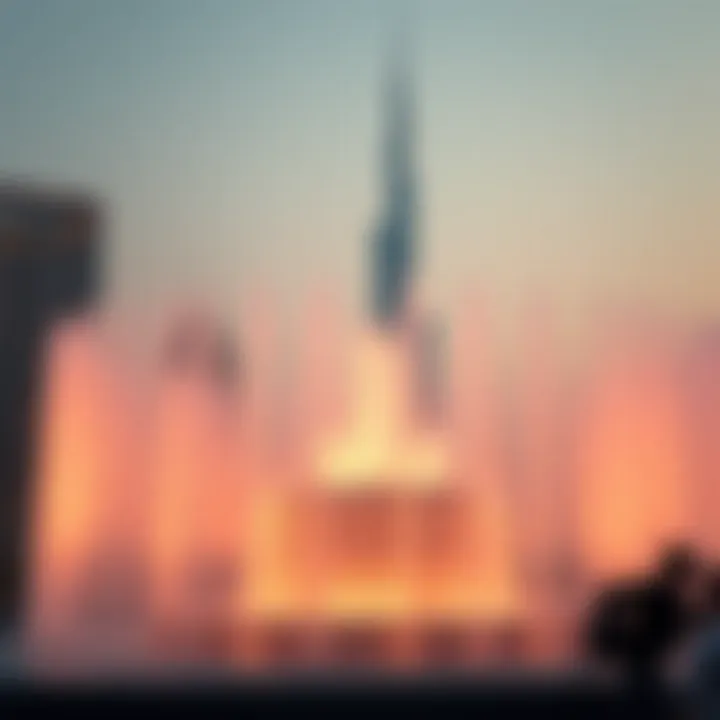
Intro
Dubai, a city intertwined with innovation and opulence, is home to one of the world's most captivating spectacles: its musical fountain. Positioned gracefully against the backdrop of the Burj Khalifa, this fountain doesn't merely splash water; it performs an artful ballet of light and sound. As we embark on this exploration, we will uncover the intricate design, cutting-edge technology, and deep-rooted cultural significance of this iconic attraction.
The fountain stands not simply as a display but as a beacon of Dubai’s aspiration, showcasing a fusion of engineering and artistic expression. By parsing through various components—from architectural details to its role in the broader urban ecosystem—we will paint a vivid picture of how this fountain contributes to the identity and allure of Dubai.
The subsequent discussion will delve into market trends and investment opportunities in areas surrounding the fountain, catering to investors, realtors, and expats looking to stake their claim in this enigmatic city.
Prelims to the Musical Fountain
The Musical Fountain stands as a captivating landmark in Dubai, epitomizing the fusion of art, technology, and cultural expression. It's more than just a spectacle; it serves as a crucial element of Dubai’s evolving identity within the global stage. This section aims to peel back the layers surrounding the fountain, considering its historical significance, location, and accessibility, weaving a narrative that highlights why it is a focal point for both residents and visitors alike.
Historical Context
The origins of the Musical Fountain date back to the ambitious plans of Dubai’s rapid development in the early 21st century. Built to complement the architectural marvel of the Burj Khalifa, the fountain reflects Dubai’s aspiration to blend modernity with tradition. Inspired by the fountains seen in cities like Las Vegas and Paris, the Dubai Musical Fountain integrates elements of local culture and history into its design and performances.
While the concept took shape in the early 2000s, the fountain officially launched in 2009, coinciding with the unveiling of the Burj Khalifa. It has since become a symbol of the city’s innovative spirit. Over the years, it has hosted a myriad of performances, ranging from classical symphonies to contemporary pop hits, appealing to diverse audiences. This evolution has created a rich tapestry of stories, with each show echoing the cultural narratives of the city.
Dive deeper into its impact, and you'll find that the fountain has served as a backdrop for significant community events, breathing life into the waterfront area alongside the Dubai Mall. In showcasing the Arabic tradition of storytelling through performance, the fountain plays an essential role in keeping local culture alive while welcoming the world.
Location and Accessibility
Situated in the heart of the city, the Musical Fountain is strategically placed between the iconic Burj Khalifa and Dubai Mall, making it incredibly accessible. Visitors can easily reach this destination by various means of transport, including the Dubai Metro, which has a dedicated stop at the Dubai Mall, or shuttle services that run frequently.
For those driving, there is ample parking available nearby, although it can fill up quickly during peak hours, particularly during the evening shows.
The surrounding promenade amplifies the experience with cafés and shops, allowing guests to savor local delicacies or shop before or after witnessing the mesmerizing water ballet. Additionally, the area has been designed with pedestrian safety in mind, featuring wide walkways and signage that guide visitors clearly to the fountain.
"Dubai's Musical Fountain is not just a show; it's an experience that connects people through the universal language of music and movement."
The seamless integration of the fountain into the urban landscape demonstrates Dubai’s commitment to creating a vibrant communal hub. Whether you're a tourist or a resident, visiting the fountain becomes a part of the shared experience, allowing everyone to partake in something truly extraordinary.
Design and Architecture
The design and architecture of the Musical Fountain in Dubai stand as a testament to the union of innovation and artistry, with a clear emphasis on functionality. The fountain's striking visual appeal is not only a significant attraction but also plays a crucial role in enhancing Dubai’s urban identity. When one considers the architectural elements, the advantages they offer, and the thoughtful considerations behind the design, it becomes evident that this development is foundational in shaping public space and artistic expression within the city.
Architectural Influences
The influences on the fountain’s design are as varied as the performances themselves. Drawing from Islamic architectural traditions, the sleek lines and fluid dynamics evoke the elegance of historic water features found throughout the Middle East. Yet, it also incorporates modernist sensibilities that reflect Dubai’s progressive ethos. The interplay of geometric shapes and natural water movement create a harmonious balance that invites viewers to engage deeply with the space.
These elements come together to create an iconic skyline feature that seamlessly integrates with surrounding structures. Moreover, the design promotes interaction; visitors can experience the fountain from multiple vantage points, allowing for unique perspectives. The thoughtful arrangement emphasizes the cultural narrative of the region and celebrates its heritage while welcoming contemporary design languages.
Construction Techniques
To bring such a visionary design to life, advanced construction techniques were paramount. The engineering behind the fountain involved specialized practices to ensure durability and performance. Notably, the use of computer-aided design (CAD) allowed architects and engineers to simulate various water patterns and movements before actual construction began. This not only streamlined the building process but also ensured that the fountain could deliver aesthetically pleasing performances.
Additionally, the construction employed precision hydraulic systems that allow for quick adjustments to the fountain’s water jets. This adaptability enables choreographed displays to match up with music, offering a synchronized experience of light and sound. Such methods enhance the fountain's reliability, creating shows that are not only spectacular but also highly controlled, irrespective of external weather factors.
Materials Used
The materials chosen for the Musical Fountain were selected meticulously to withstand Dubai’s harsh climate while providing a striking visual effect. Low-maintenance materials such as stainless steel were favored for fountain components, allowing for resilience against corrosion while maintaining a sleek appearance. The bases and supporting structures often utilize reinforced concrete, ensuring the fountain's stability and longevity.
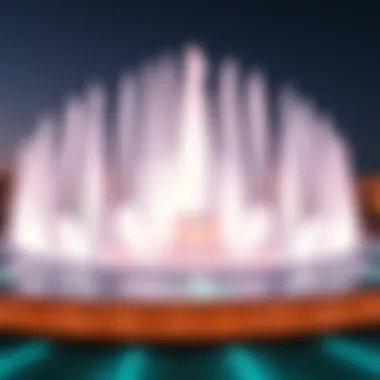
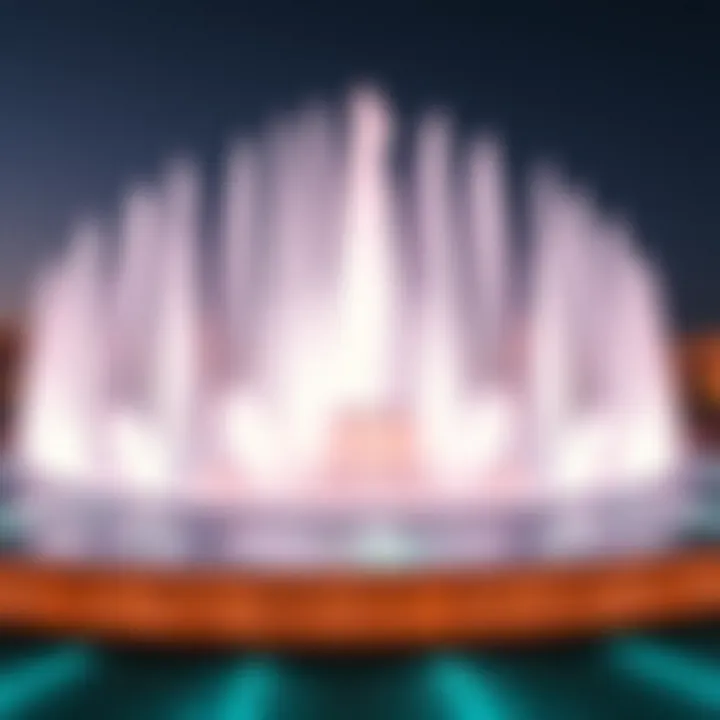
Furthermore, eco-friendly considerations influenced the selection of materials. Water recirculation systems were implemented, allowing for minimal water wastage and offering a sustainable approach to operation. This reflects a growing trend in urban development that aims to balance luxury with environmental responsibility.
In summary, the design and architecture of the Musical Fountain are integral to its cultural impact. By infusing traditional influences with modern techniques and materials, this attraction not only enhances the urban landscape of Dubai but also positions itself as a symbol of the city’s enduring innovation and artistry.
Technological Aspects
The Technological Aspects of the musical fountain are nothing short of fascinating. They embody a blend of artistry and engineering that not only captures the awe of onlookers but also drives significant investment and innovation in urban planning. These elements are crucial in ensuring that the fountain remains a state-of-the-art spectacle, seamlessly combining visual allure with intricate mechanics. The focus here is threefold: on water systems and mechanics, lighting and sound integration, and control systems. Understanding these elements provides insight into how this marvel of modern design enhances the urban landscape of Dubai.
Water Systems and Mechanics
The water systems and mechanics, behind the musical fountain is where the magic truly begins. The fountain utilizes advanced hydraulic technology to create its stunning water displays. By precisely controlling water jets, the designers can manipulate height and shape, making the fountain dance rhythmically with the accompanying music. This dynamic display is orchestrated by a series of pumps and computerised systems that ensure efficiency and elegance in performance.
- Jet Variability: The system uses jets that can produce different heights and shapes of water streams. This variability allows for unique displays during each performance.
- Water Recycling: An efficient water management system recirculates water, ensuring sustainability and reduced consumption. This helps in minimizing waste, which is critical in a desert environment like Dubai.
The importance of these systems cannot be overstated; they not only amplify the aesthetic appeal but also highlight the framework of resource sustainability, vital to any modern city's ethos.
Lighting and Sound Integration
Next up is the lighting and sound integration, vital components that elevate the fountain experience from mere water choreography to an immersive spectacle. The LED lights used in the fountain are high-efficiency and programmable, allowing for a wide spectrum of colors and intensities.
The choreographed lighting synchronizes with the music, creating a captivating scene that enchants viewers. Here are some noteworthy points about this integration:
- Color Control: Each LED can be controlled individually, which means that light shows can be tailored to various themes or events, enhancing the user experience.
- Acoustic Projection: The sound system is meticulously integrated to ensure that music is not only heard but felt. The fountain complements auditory emotion through aligned water movements, which is as much an engineering feat as an artistic one.
This marriage of sound and visual elements creates a multi-sensory environment that attracts not just locals but tourists from far and wide.
Control Systems
Finally, we must discuss the control systems that serve as the brain of the fountain. These sophisticated systems allow for real-time adjustments, enabling operators to create dynamic performances that respond to audience reactions or environmental conditions. Essentially, the control systems facilitate:
- Programmability: Operators can schedule performances and customize them for special occasions. This versatility helps keep the shows fresh and engaging.
- Remote Management: Advanced technology enables remote control from various devices, enhancing the ease of operation and allowing for rapid response to technical issues or spontaneous changes.
The musical fountain is a testament to what can be achieved when art meets technology, creating a landmark that proudly showcases the spirit of Dubai.
For more information on the technology behind urban fountains, you can visit Wikipedia or explore discussions on platforms like Reddit.
Cultural Significance
The musical fountain in Dubai stands as more than just an engineering marvel; it embodies a deep cultural resonance that speaks to both the heritage and the modernity of the Emirati people. Its importance extends beyond mere entertainment; it represents a synthesis of art, technology, and tradition that captivates residents and tourists alike. Understanding the cultural significance of the fountain reveals the careful thought that went into its creation, reflecting the values and aspirations of Dubai.
Symbolism in Emirati Culture
In Emirati culture, water has always been a vital resource, symbolizing life and prosperity. The fountain echoes this symbolism not only through its enchanting displays but also by embodying the region's historical reliance on water sources. The cascading sprays of water and vibrant dance movements resonate with the spirit of the desert, where water is often seen as a precious gift. Visitors may notice how the dances mimic the rhythms of traditional Emirati music, intertwining the cultural legacy with contemporary artistry.
The use of local music during the fountain's performances enhances its cultural weight. For instance, the inclusion of Arabic melodies serves to connect the audience with their roots, celebrating their national identity while embracing global influences. Each performance becomes a moment of collective reflection on what it means to be part of a rapidly evolving society while holding onto cherished traditions.
Influence on Local Art and Events
The presence of the musical fountain has had a significant impact on local artistry and events, prompting a renewed interest in public art. It has inspired local artists to incorporate water features into their designs and performances, nurturing community engagement through the arts. For instance, numerous festivals have emerged around the fountain, drawing on music, dance, and visual art, further enriching Dubai’s cultural scene.
Local art galleries and cultural institutions have also begun to curate exhibitions that reflect themes of water, movement, and sound, echoing the fountain's influence across different platforms. Events like the Dubai Shopping Festival and New Year's celebrations showcase performances staged near the fountain, creating an electrifying atmosphere that invites both locals and expatriates to partake in cultural exchanges.
This blending of artistry with the fountain has opened doors for collaboration, dialog between artists and audiences, and has even sparked discussions about the role of art in urban spaces. It is not just a focal point for tourists, but a proud centerpiece for the Emirati community, fostering a sense of connection and belonging in a bustling city.
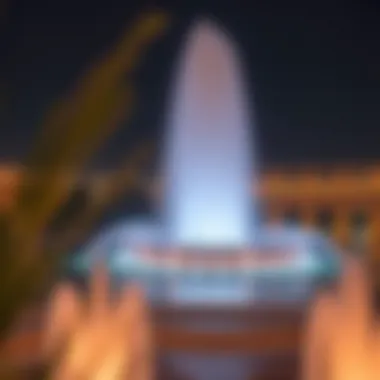
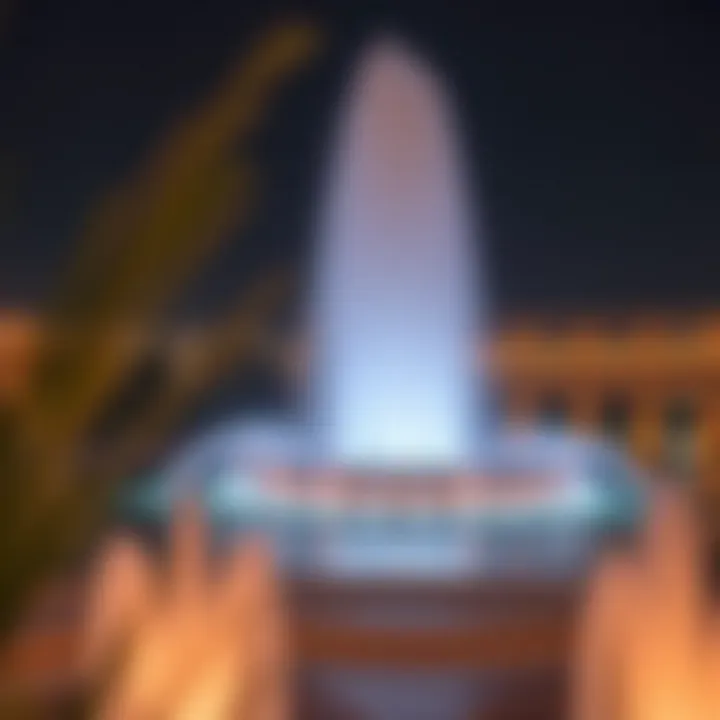
Ultimately, the musical fountain is not just about water and light; it's a vivid reflection of Dubai's identity, unifying various aspects of culture and community engagement. Through this remarkable spectacle, the fountain positions itself as a significant cultural icon, connecting the past with the present in ways that resonate with all who experience its magic.
The Fountain and Dubai's Urban Landscape
The musical fountain, a hallmark of Dubai's architectural splendor, presents more than just a captivating display of water and light. It plays a crucial role in the city's urban landscape, defining its cultural identity and influencing various aspects of daily life. Its integration is not merely functional but also symbolic, illustrating the vision of Dubai as a global metropolis. The fountain stands as a testament to the marriage of art and urban development, compelling both residents and visitors alike to engage with the bustling environment around it.
Integration into City Planning
The planning of Dubai's urban environment has always emphasized the juxtaposition of natural beauty and modern infrastructure. The fountain occupies a strategic position at the heart of Downtown Dubai, adjacent to the iconic Burj Khalifa and the Dubai Mall. This deliberate placement enhances the pedestrian experience, creating a focal point that draws crowds and serves as a natural meeting spot.
In many ways, the fountain complements the architectural style of its surroundings. Local government recognized early on that this vibrant feature would not only beautify the area but also enhance public spaces. The integration of the fountain into the cityscape reflects thoughtful city planning—merging aesthetic considerations with community functionality.
Moreover, the fountain acts as a catalyst for further urban development. Properties nearby often see increased valuations as they benefit from the foot traffic and tourism generated by the performances. For homeowners and investors, being close to such an attraction can yield a higher return on investment in terms of rental prices and resale value. As the city expands, creating public amenities like the fountain remains essential to maintaining a livable, vibrant urban space.
Role in Tourism Development
Tourism is an integral part of Dubai's economy, and the fountain serves as a major draw for visitors from around the world. Each performance, characterized by a choreographed harmony of water, music, and lights, encapsulates the essence of Dubai’s identity—luxurious, innovative, and enchanting. Tourists flock to witness these shows, enhancing the city’s reputation as an international tourist destination.
From a practical perspective, the fountain not only attracts tourists but facilitates spending within the local economy. Many visitors extend their stay to dine at nearby restaurants or shop in the expansive mall, leading to increased revenue for the city. It’s worth noting that tour operators often include the fountain in their packages, ensuring that tourists experience this famed attraction, which further solidifies its status as a must-see destination.
Furthermore, the success of the fountain has inspired other cities worldwide to explore similar concepts, leading to a global interest in musical fountains. The unique amalgamation of cultural narratives and technological prowess captivates guests, providing not just a visual spectacle but also an opportunity for artistic engagement. This ripple effect amplifies the cultural dialogue, fostering connections between Dubai and the global community.
Ultimately, the fountain’s role in enhancing Dubai's urban landscape cannot be overstated. Its design and placement are deliberate elements of a broader strategy to position the city as an innovative leader in architecture and tourism. Accordingly, the musical fountain isn’t merely an artistic endeavor; it embodies Dubai's dynamic spirit and demonstrates how urban spaces can be transformed into vibrant communal hubs.
Public Reception and Cultural Impact
The response to the musical fountain in Dubai has been overwhelmingly positive, cementing its place as both a marvel of engineering and a staple of the city’s cultural identity. The variety of experiences it offers has made it a central point of attraction, with countless individuals flocking to witness its synchronized displays of water, sound, and light. Not only does it captivate tourists and locals alike, but it also serves as a powerful symbol of modernity juxtaposed against the historic roots of the Emirate.
Visitor Experiences
Visitors come not just for the exquisite shows, which differ in style and music every season, but also for the overall ambience. Standing before the fountain, one can feel the energy pulsate through the crowds as onlookers are mesmerized. The carefully choreographed performances often involve international music selections, ranging from classical to contemporary hits.
- Engagement: People engage in a communal experience, with families, couples, and friends often traveling from afar just to witness a slice of this spectacle. For many, it has become a cherished tradition, a part of their social calendar.
- Shared Joy: There’s something innately human about gathering around art, and this fountain certainly packs a punch. Alongside casual conversations, cheers, and gasps, the shared moments become stories—"Did you see that fountain dance to 'Titanic'?" or "The lights were so vibrant!"
- Accessibility: Its location near souks and high-end shopping areas plays into this accessible experience, allowing a day filled with shopping or dining to be capped off with an enchanting fountain display.
Through these engagements, visitors leave with more than just memories; they carry with them a taste of Dubai’s essence—a blend of tradition and avant-garde innovation that leaves its mark on every tourist.
Social Media and Artistic Engagement
Social media has amplified the musical fountain's cultural significance, allowing users from around the globe to share their unique experiences. Platforms like Instagram, Facebook, and TikTok have turned the fountain into a visual phenomenon. The consequences of this modern engagement are profound:
- Viral Reach: Clips of the fountain's performances tend to go viral, bringing attention to Dubai’s vibrant scene and intriguing potential visitors. A simple share from the right influencer can invite thousands to consider Dubai their next holiday destination.
- Artistic Interaction: Local artists have begun creating works inspired by the fountain, showcasing it through photography and paintings that portray their interpretation of this landmark. This crossover between technology, art, and culture is a remarkable example of how public installations can stimulate artistic expression.
- Community Engagement: There are also happenings designed around the fountain, from photography contests to music festivals, fostering a sense of community involvement that extends beyond mere observation. These events not only highlight the fountain's importance but promote local artists and businesses as well.
"The fountain isn't just a show; it's a canvas where music, water, and human emotion intersect, making it a living part of our urban culture."
The narrative built around the musical fountain is one of connection, community, and the ever-evolving culture that makes Dubai distinct. Through social media and enriched visitor experiences, it shapes and reflects the artistic and social landscape of the city—an element that enriches its urban tapestry.
Economic Implications
Understanding the economic implications of the Musical Fountain in Dubai is key for various stakeholders. This section sheds light on how this iconic attraction doesn’t just mesmerize audience member, but also stimulates the local economy in significant ways, intertwining art and commerce.
Impact on Real Estate Prices
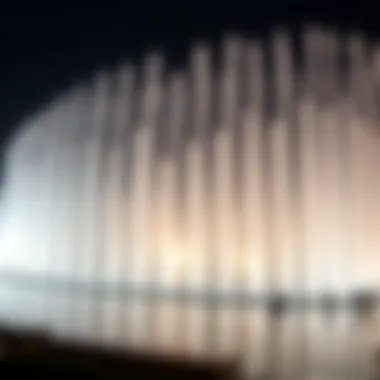
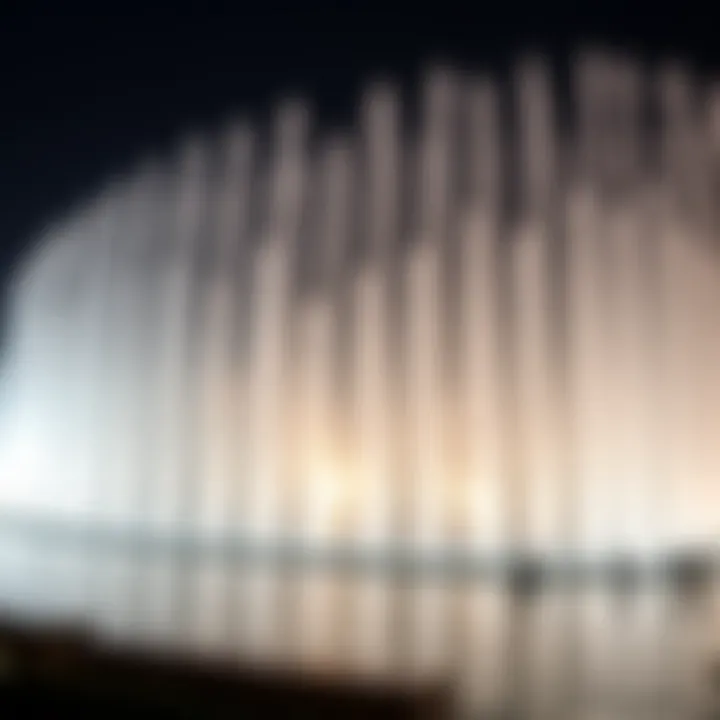
The presence of the Musical Fountain has inevitably woven itself into the fabric of real estate trends in Dubai. Properties near the fountain often see a hike in their prices. This is not mere coincidence; several factors contribute to this spike.
- Increased Demand: For homebuyers and investors, proximity to popular attractions such as the Musical Fountain becomes a priority. Whether it’s the allure of a breathtaking view or easy access to entertainment, these factors drive demand.
- Enhanced Perception: Living near a globally recognized landmark heightens a property's appeal. People want to be part of the vibrant atmosphere that such sites offer. Area developers take note. They market properties with features that highlight the fountain's proximity, adding to its allure.
- Long-term Value: Properties in regions near prominent attractions tend to retain their value over time. With the influx of tourists and residents enjoying the performances, the potential rental income and long-term stability appeal to investors.
"Investors see the Musical Fountain not just as a spectacle, but as a cornerstone of real estate development in the region."
In essence, the fountain doesn’t just serve as an entertainment space; it works as a catalyst for real estate appreciation, influencing both residential and commercial property sectors.
Investment Opportunities Surrounding the Fountain
The economic landscape surrounding the Musical Fountain presents various investment opportunities that savvy investors and entrepreneurs should explore. From retail to hospitality, the fountain catalyzes growth through the influx of visitors.
- Retail Ventures: With a steady flow of foot traffic, businesses such as cafes, restaurants, and shops can flourish nearby. Investing in retail spaces can yield substantial returns, particularly if they offer unique products or experiences that tie in with the fountain's performances.
- Hospitality Growth: Hotels and serviced apartments springing up near the fountain capitalize on the location’s appeal. Visitors frequently seek accommodations providing easy access to the fountain, prompting investors to consider developing hotels that cater to tourists and business travelers alike.
- Event Spaces: Entrepreneurs can capitalize on the fountain's popularity by creating versatile event spaces. Hosting gala events, weddings, and corporate functions near the fountain can draw in clientele looking for distinctive venues with breathtaking views.
Engaging with the potential of the area means looking beyond the flickers of light and music; it is about recognizing the pulse of the Dubai economy as it swells around this iconic feature. This attraction is reshaping possibilities and creating avenues that extend far beyond being merely a stunning visual marvel.
Future Prospects and Innovations
The realm of musical fountains is continuously evolving, and the Dubai fountain stands at the cusp of future advancements. The significance of exploring future prospects and innovations cannot be overstated, especially in the context of a rapidly growing city like Dubai. It not only showcases the blend of aesthetics and technology but also hints at Dubai's aspirations to remain at the forefront of global entertainment. The continuous improvements in technology, design ethic, and user experience are key considerations that can reshape how these attractions interact with their audience.
Potential Upgrades and Maintenance
When we look ahead, potential upgrades to the musical fountain in Dubai could involve enhancements in its water choreography, sound system, and integration of energy-efficient technologies. For instance, incorporating LED lighting with smarter controls can enhance the visual display while reducing energy consumption, a consideration that aligns with Dubai's sustainability goals.
Maintaining such a grand structure requires not only routine checks but also specialist skills. For example, personnel trained in hydraulic engineering might be necessary to keep the water systems functioning at peak efficiency. Regular maintenance can also include checking electronic systems to ensure sound clarity and synchrony with the water displays. The costs associated with these upgrades and maintenance should also be a part of the conversation, as they can drastically influence the overall operational budget.
"Investing in modern technology is crucial not only for aesthetic appeal but also for operational efficiency.”
This idea resonates especially well within the context of real estate; properties nearby may fetch higher values with enhanced attraction offerings.
Expanding the Concept of Musical Fountains Globally
The concept of musical fountains isn't confined to Dubai. Globally, cities are beginning to adopt similar attractions—but the degree of innovation varies widely. For instance, cities like Las Vegas and Singapore have their own themed fountains, yet the integration of advanced tech may not be as refined. Thus, the success of Dubai’s fountain could serve as a blueprint for urban planners worldwide.
In expanding this idea globally, lessons can be learned from other cultural contexts. For example, adapting traditional musical genres from various parts of the world can offer a richer experience. Imagine a musical fountain that features the sounds of various global music styles, synchronized with culturally relevant water displays. This would not only attract tourists but also engage local communities.
Leveraging social media platforms can enhance marketing for new musical fountain projects, encouraging community involvement and feedback. As more cities invest in their own musical fountains, sharing these practices could help in establishing a standard of excellence that keeps the allure of such attractions alive, continuously adapting to modern tastes and technologies.
Finale
The conclusion of this piece encapsulates the intricate relationship that the Musical Fountain holds with both its urban environment and the cultural tapestry of Dubai. This fountain is not merely a water spectacle; it stands as a beacon of innovation and an emblem of what Dubai represents in the modern world. The importance of the fountain’s role in fostering tourism and enhancing the city's global image cannot be overstated, making it a vital attraction in a bustling metropolis.
Recapitulating the Fountain's Role in Dubai
When discussing the fountain's role in Dubai, it’s essential to highlight its dual function as an entertainment spectacle and a cultural landmark. Since its inception, the fountain has become synonymous with the city itself, attracting countless visitors each year. It transforms a simple visit to the Burj Khalifa area into a multi-sensory experience. The scheduled shows, set against the backdrop of the towering skyscrapers, offer an enchanting spectacle that visitors eagerly anticipate.
Moreover, the fountain has become a social hub where families gather, couples create memorable experiences, and tourists marvel at a unique blend of art and engineering. This convergence of diverse individuals reflects the city’s nature—diverse yet united.
"The fountain embodies Dubai's ethos, where tradition meets modernity, encapsulating the city’s spirit in its every splash."
Additionally, the fountain serves as a vehicle for promoting Emirati culture on an international stage. The music chosen for the shows often includes traditional Emirati compositions, which adds layers of meaning to the visual delight. These acts connect on an emotional level, etching memories into the minds of the audience and reinforcing a sense of place and identity.
Reflecting on Urban Development and Culture
In the grander scheme, the Musical Fountain represents a significant aspect of Dubai’s urban development strategy. Its location is meticulously chosen—not just for visibility but for its role in urban cohesion, bringing together recreational space and the urban landscape. This planning reflects a broader vision of integrated living, where cultural and recreational elements coexist.
The fountain’s integration into the urban fabric underscores how art can inform environment, allowing for moments of respite within the fast-paced life of the city. This thoughtful approach goes beyond aesthetics; it considers the well-being of residents and visitors alike, encouraging them to engage with their surroundings.
Furthermore, the fountain acts as a catalyst for various cultural events. Its presence fosters opportunities for artist showcases, seasonal events, and community gatherings, all contributing to the rich cultural life of Dubai. These activities not only enhance social interactions but also deepen the connection that the residents have with their city.



